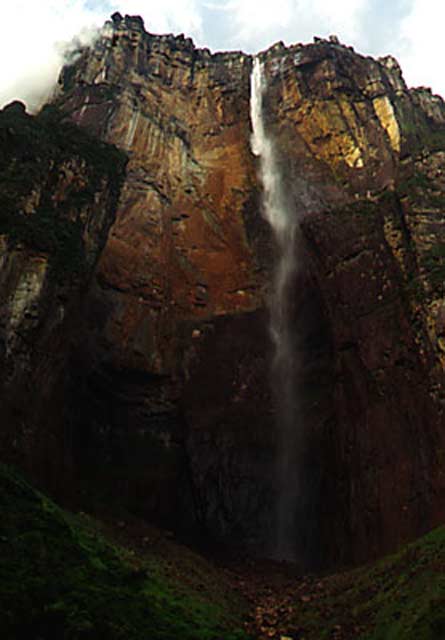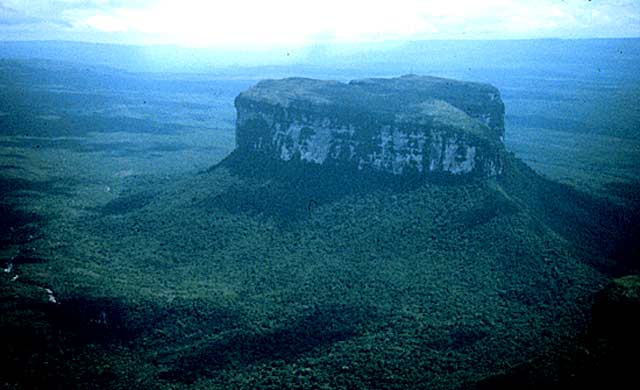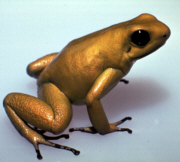Spirit Away
Rising Tide of Development Laps Evolution's IslandsEvolution is not a force but a process. Not a cause but a law. - John Morley
by Raymond Collitt Canaima National Park, Venezuela - Rising ominously out of nature's colour puzzle are South America's mystical "tepuis" or table mountains, which are believed to have been formed 1.5 - 2 billion years ago during the Precambrian period, making them some of Earth's oldest rock formations. Towering above dusty savannah or dense jungle, they mark what is likely to have been the original junction between South America and Africa, the supercontinent of Gondwana. Indeed, the tepuis consist of similar material to the cliffs and mesa-like mountains in the western Sahara. The site is southeastern Venezuela's Canaima National Park, one of the world's largest parks. It's where the Great Savannah meets the northeastern edge of the vast Amazon rainforest in a riot of exotic vegetation. Viewed from above, open grassland blends with high-altitude, evergreen and cloud forests merge into a mosaic of deep olive and shades of arid brown. Jagged and colossal, the tepuis have a mystical air, heavy with prehistoric, magical images. At 9,147 feet above sea level, the highest is Mount Roraima, cradling the borders of Venezuela, Brazil and Guyana. Exposed to erosion by rain, wind, algae and fungi, the tepuis have taken on bizarre shapes. The twisted rock formations on their surface resemble a lunar landscape, conjuring up images of ancient civilisations or dinosaurs fossilised with time, or of strange forces at work. Canaima, the name of the park, means "spirit of evil" in the language of the Pemon, the principal native group living in the region. Tepuis are true islands in time, some of the few places on Earth where the flora and fauna have grown for eons without outside influence. Plants and animals have evolved to suit the inhospitable climate of the often soilless, windswept plateaux pounded by torrential downpours. Notorious are the "puri-puri" insects, which, despite their endearing name, may well be the planet's most bloodthirsty creatures. Nearly invisible to the eye, they are known to have driven the unprepared visitor insane. Sir Arthur Conan Doyle was inspired by the landscape without ever having been there. The travel tales of a British botanist returning from Venezuela to London formed the basis for Doyle's "The Lost World," published in 1912, which describes the ascent of a fictitious mountain inhabited by prehistoric plants and dinosaurs. A passage from it describes one of the countless rivers nourished by the tepuis and eventually draining into the mighty Orinoco:
The gem of the park is Angel Falls, the world's highest uninterrupted waterfall, dropping nearly 1,000 metres. It is named after Jimmy Angel, an intrepid American pilot and adventurer who in 1935 landed on top of the tepui despite protests from the gold-prospecting customers accompanying him. The Auyan tepui is so large that its rainfall and moisture are enough to feed Angel Falls all year long. When the peak of the Auyan tepui is wrapped in haze, the water appears to fall straight from the sky, releasing a cloud of mist and crashing thunderously on the rocks below. Yet only a few hundred yards downstream a natural pool allows the visitor an angelic bath after the half-hour walk uphill to the base of the cataract. A trip down the Churun River, which gives access to the falls, is an open window on native life. Pemon Indian women crouch on the bank washing clothes before their thatched huts. Others grate manioc, which is later processed into cassava bread or a fermented drink. A group of men fish in a tributary half concealed amid the towering reeds. From deep within the rainforest the roar of a band of howler monkeys reverberates around the vast bare rock wall of the Topochi tepui as the rising sun begins to burn away the early morning mist. Yet the idyllic scenery and tranquillity are deceiving. The shimmering alluvial gold deposits that attracted Jimmy Angel decades ago still draw modern-day conquistadors to explore the subsoil of the Guyana Shield, South America's oldest rock foundation. Miners and lumbermen are encroaching on the boundaries of the park, destroying the forest and poisoning the rivers with mercury, threatening the survival of the native people and that of the flora and fauna. Canaima itself is known to have vast gold and diamond deposits, and the few park guards are poorly paid and equipped to fend off wildcat miners. Tourism, a newly paved road and the burning of the forest by the region's expanding indigenous population pile pressure on the park's natural resources. This is forcing officials to rewrite regulations for the eastern half. The new plan foresees training and recruiting natives as park guards to help patrol the area and improve the dialogue with the native population at large. The idea is not to ban tourism or agriculture entirely but to regulate the activities in such a way as to offer an alternative source of income while minimising the environmental impact. Some of the natives recognise the need for environmental protection measures and are willing to participate. But many natives in this land of magic and mystique continue to believe that the majestic tepuis are the guardians of the savannah. "It is where the Great Spirit lives," says an elderly Pemon man, pointing to the top of Auyan tepui, where Angel Falls and a frail rainbow disappear into a lofty cloud. Source: from The Financial Times 8 July 1998 distributed by Scripps Howard News Service © Nando.net and Scripps Howard
Photos source: nutahsa.com
What Is the Most Poisonous Creature on Earth?Most Poisonous Creature Could Be a Mystery Insect
The extremely toxic P terribilis by April Holladay Colombia, South America - Midday, in the depths of a jungle west of the Andes along a Pacific river, it is dark, hot, and dismal far below the light-blocking tree canopy. Dusk never leaves the day. Rainwater pools in huge, still leaves. A heavy atmosphere clings to the earth like a coiling miasma. "Thwoop," breaks the silence as a poison dart hurtles from a blowgun to its target: a howler monkey secure on a lower branch of a tree towering a hundred feet above the rain forest floor. The dart penetrates the monkey's reddish fur, into her flesh and bloodstream. She falls, paralysed, unable to breathe, and her heart fails. The poison from the skin of the world's most poisonous known creature - the tiny, 1.5-inch, Golden Poison Frog, Phyllobates terribilis - kills the monkey. An average P terribilis contains about one milligram of poison, which is enough to kill 10,000 mice-perhaps enough to kill 10 to 20 humans if the poison reaches their bloodstreams. This extraordinarily lethal poison (a steroid alkaloid, called batrachotoxin) almost does not occur in nature. We have found this poison only among three poison frogs in Colombia and two poison birds in Papua, New Guinea. The yellow frog stores the poison in skin glands, as do most frogs. Their poison makes the frogs taste awful to predators but P terribilis' poison kills whatever eats it - except for one kind of snake, Liophis epinephelus. This snake is resistant to the frog's poison but not immune. "We fed one juvenile frog to a snake and the snake showed great distress and was rendered helpless for several hours," says John Daly, chief of the National Health Institute's bioorganic chemistry laboratory. The poison frogs are perhaps the only creatures immune to this poison. The poison attacks the sodium channels of the cells. Through the ages, the clever frog has evolved special sodium channels that the poison cannot harm. Frogs normally have no occasion to eat their own poison but this frog is different. The frog apparently eats the same poison as his own but produced by some other creature. He eats the unknown creatures as we might eat shrimp or chicken: just standard food. Frogs grown in captivity, however, can't eat the same food and they are not poisonous. "All evidence indicates that such frogs obtain the poisons unchanged from some creature in their diet," says Daly. "Thus, the high toxicity of P terribilis appears due to consumption of an unknown mysterious small insect or other arthropod, which may truly be the most poisonous creature on Earth. It is a mystery that we hope to someday solve." Source: USA Today 7 June 2002 photo credit Charles W Myers, American Museum of Natural History See also:
For pages on several types of natural disasters - including lightning strikes, tornados, hurricanes, volcanoes, floods, global warming and
more - as well as some great satellite and tree photos, clicking the "Up" button immediately below takes you to the Table of Contents page for
this Environment section. |
 Animals
Animals Animation
Animation Art of Playing Cards
Art of Playing Cards Drugs
Drugs Education
Education Environment
Environment Flying
Flying History
History Humour
Humour Immigration
Immigration Info/Tech
Info/Tech Intellectual/Entertaining
Intellectual/Entertaining Lifestyles
Lifestyles Men
Men Money/Politics/Law
Money/Politics/Law New Jersey
New Jersey Odds and Oddities
Odds and Oddities Older & Under
Older & Under Photography
Photography Prisons
Prisons Relationships
Relationships Science
Science Social/Cultural
Social/Cultural Terrorism
Terrorism Wellington
Wellington Working
Working Zero Return Investment
Zero Return Investment

